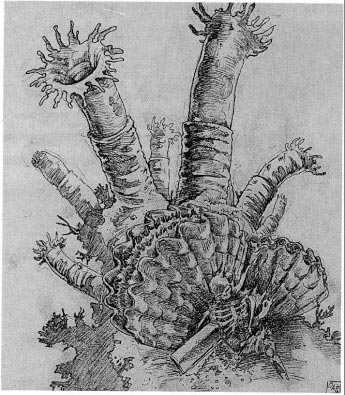
| Common | Carnivorous | |
|---|---|---|
| Climate/Terrain: | Deep ocean/Hydrothermal vents | Deep ocean/Hydrothermal vents |
| Frequency: | Rare | Very rare |
| Organization: | Colony | Clump |
| Activity Cycle: | Any | Any |
| Diet: | Suspension feeder | Carnivore |
| Intelligence: | Non- (0) | Animal (1) |
| Treasure: | Nil | See text |
| Alignment: | Neutral | Neutral |
| No. Appearing: | 20-200 | 2-8 |
| Armor Class: | 2/7 | 2/7 |
| Movement: | Nil | Nil |
| Hit Dice: | 1+1 | 2+2 |
| THAC0: | Nil | 19 |
| No. of Attacks: | 0 | 1 |
| Damage/Attack: | Nil | 2-8 |
| Special Attacks: | Nil | Surprise, poison |
| Special Defenses: | Alert | Nil |
| Magic Resistance: | Nil | Nil |
| Size: | M (6' long) | M (6' long) |
| Morale: | Unreliable (4) | Steady (11) |
| XP Value: | 35 | 120 |
Giant tube worms are a fairly common sight near hydrothermal vents. The mundane variety consist of pacific suspension feeders, measuring about 6' high and 2' in diameter. They possess an extremely durable outer casing of a dark yellow coloration. Their bodies are of a pale yellow. The heads are topped with flowery appendages and are extended while feeding.
Carnivorous tube worms, also known as blood worms, closely resemble their peaceful relatives but are thankfully more rare. Their heads lack the flowery appendages of the common variety; instead, they are adorned with wide mouths containing an extremely wicked set of sharp teeth.
Combat: The common giant tube worm has no form of attack. As its body is comparatively vulnerable (AC 7), it relies on its shell to provide it with protection (AC 2). The worm can sense pressure caused by either sound or movement and is thus very difficult to surprise (+2 bonus to avoid surprise). Should it feel threatened by the approach of another creature, which is almost always the case, the worm withdraws inside its tube. A valve (AC 2) seals the tube from the top, and the animal is then well protected from attack.
Carnivorous giant tube worms are usually encountered hidden among the more common variety and are 90% indistinguishable from the latter. They typically lie in wait for a suitable meal to pass by, then strike out with speed and ferocity (+2 to surprise roll). The body of a worm is extremely flexible and can extend to 3' in all directions from the top of its tube. Carnivorous tube worms are unpleasant fighters: In addition to their nasty teeth, they secrete a weak poison through their saliva (save vs. poison at +2 or lose 2 points of Dexterity for 1d6 turns from burning and itching). They are not, however, overly brave, and if they lose more than 50% of their hit points they retreat to the comparative safety of their tubes.
Habitat/Society: Giant tube worms are found exclusively in the vicinity of hydrothermal vents. Generally, the hotter the water (and therefore the more nutrient rich), the more worms are found. Both types of worms are exclusively sexually reproductive. The young, numbering several thousand, are emitted from a genital valve found near the head on the female. While neither type of worm collects treasure, some items may (rarely) be found near the base of the carnivorous variety.
Ecology: The common giant tube worm lives in a symbiotic relationship with chemosynthetic bacteria. The bacteria are found in the guts of the worm and convert mineral particles into food. The worms serve as a source of food for many creatures, and their hollowed-out tubes are often used as lairs. Most creatures not native to hydrothermal vents find the worm's meat inedible because of its high sulfur content.
Carnivorous giant tube worms eat almost anything they can grab and are considered a great nuisance by deepdwelling octopi.
by Bryan K. Bernstein
